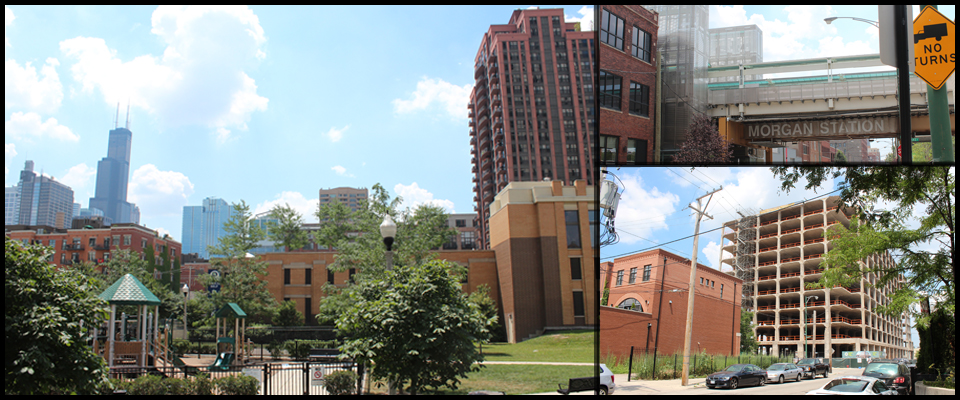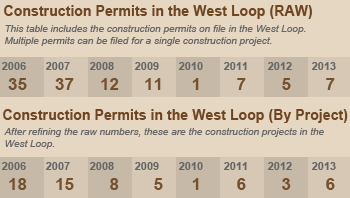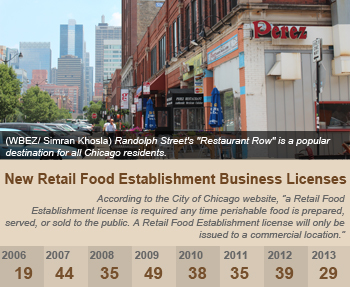The West Loop boom
By Simran Khosla

The West Loop boom
By Simran Khosla
Last month, Google decided to plant roots in Chicago’s West Loop, following recent moves by many new residents and businesses as this once industrial area is now seeing more BMWs than delivery trucks.
For the past few years the West Loop has seen a massive surge in development, as it rebounds from the recession. Apartment buildings, corporate offices, restaurants, bars, grocery stores and countless other forms of construction have taken places in the area. On Thursday, the city approved plans for the development of the Old Chicago Main Post Office. Meanwhile, scores of new residents have moved in to the new high-rises that make up a drastically changed skyline.
“If you saw a picture of this area 35 years ago, it was a frightening looking area, everything was sort of in shambles,” said longtime Chicagoan John Kelly, referring to the Fulton river side of the West Loop.
Last year, however, Kelly opened The Point, a new bar in the middle of the neighborhood he was once so scared to visit.
“We’re being surrounded by more and more apartment buildings… and now [the West Loop] is really taking off,” Kelly said.
The Near West Side community area, which encompasses the West Loop neighborhood, has seen an 18.8 percent population increase from 2000 to 2010, according to U.S. Census data. Aside from Google, the area has attracted businesses that have flocked to the neighborhood to serve the demand of the new residents.
“Just about every investor and developer on the local and national scene here is actively pursuing property in this neighborhood,” said Wayne Caplan, a member of the Chicago Association of Realtors Board of Directors. “Whether it’s Google in the 1000 Fulton project or Rick Bayless on Randolph Street there are lots more high profile retail and office tenants interested.”
Historically, the West Loop has been home to industrial warehouses. A few blocks away from the interstate expressways, the West Loop was the perfect location for warehouses. In the glory days of Fulton Market, mornings were signaled by the smell of stock being piled into delivery trucks. Around the ’80s, developers began converting abandoned industrial buildings to high-end lofts, replacing the blue collar workers on the streets with a much younger crowd of club-goers and restaurant aficionados.
Occasionally, you can find a functional factory in the neighborhood around W Fulton Market, but being a stone’s throw away from the massive 1000 W Fulton project may quickly lead to the few remaining warehouses being bought out and replaced with boutique hotels, restaurants and residences.

Elkwood Resident Cathy Nitti is the manager of the City Pool Hall, a 15-year-old establishment located on the corner of Hubbard and Des Plaines. She describes how the area is barely recognizable compared to when she began working in the neighborhood seven years ago.
“It was like a dead-end street, other than this big chocolate factory there was nothing,” she said. “This area has changed a lot.”
By examining the building permits authorized by the city since 2006, we can see what Nitti is referring to.
While the recession had a big impact on new construction, the West Loop seems to be on the upswing with the number of construction permits filed this year already double that of last year.
 |
The big jump in 2012 is mostly street festivals along Randolph St. which had 118 new business licenses issued mostly in Union Park and for the Taste of Randolph St food fest. |
 |
 |
| There have been only 8 new issuances since 2006, but 108 renewals. Most of which are concentrated around Union Park and 1431 W Lake Mezzanine. |
 |
| 23/69 are on Randolph St. |
 |
| 11/23 are on Randolph St. All business licenses information was extracted from the City of Chicago data set. |
The biggest construction trend has been high-rises. Since 2006, there have been eight major high-rise developments in the West Loop. Five of these buildings are over 35 stories tall.
Those five buildings are Left Bank (37 stories), Echelon (39 stories), K2 (36 stories), Alta – West Tower (37 Stories), and the Alta-East Tower (37 stories). Together, these five buildings make up the K-Station, a project by developer Fifield Cos. The project began in 2005 and, according to chairman and CEO Steve Fifield, consists of 2,145 apartment units.
And that’s only the largest slice of the residential pie. Of the 62 construction projects that took place between 2006 and 2013, most are multi-story townhouses or high-rise developments.
“Part of the apartment demand is driven by more favorable sentiment towards renting,” Fifield said. “Too many people bought condos earlier and got burned [by the recession]. Those buyers are now renters.”
The high-rises also offer an interesting commercial opportunity to the community. Many of the larger condominiums have dry cleaners, gyms with hired trainers, and other job options for Chicagoans.
The high-rises provide a constant flow of customers to the businesses housed within them.
“We have a lot of residents who dine here and order in upstairs,” said Luz Figueroa, manager at the Blue Agave restaurant, which is tucked into the bottom level of the West Tower of the Alta high-rise.
“With grand openings of places like Target, Mariano’s, Walmart, Jewel, Dominicks over the years, the infrastructure is there for the development of residential condos to attract consumers who know their needs will be met when they walk out their front door,” said Residential Consultant and realtor Samantha Powell.
But not everyone is as thrilled about the changing skyline in the neighborhood.
“I’m one mile west [of the K Station] and my apartment is old-school Chicago awesomeness,” said West Town resident Jamie Enskat, “and for the same amount these people chose to live in a box, it’s just so not Chicago, except for the view I guess. But they do it because there’s a Jewel’s across the street and they can get on the highway.”
Access to transportation has played a huge role in attracting new residents to the West Loop. According to residential consultant Powell, residential development is attracted to the area because of transportation convenience. The area is well connected to major expressways, a walk away from Downtown, the recipient of a new CTA “L” stop, and filled with new Divvy bike stations.
West Loop resident Jenna Reddington moved into the neighborhood in 2009. She said she’s seen the area change dramatically, even over just the last four years.
“[My husband and I] used to never be able to get a cab and now there’s always tons around,” Reddington said. “Also, there’ve been a bunch more “neighborhoody” places popping up like all the bars up on Randolph.”
It’s also important to note that the West Loop contains nine TIF districts. To see which of the construction projects in the West Loop were paid for by TIF funds, see this map of Chicago TIF Projects created by Derek Eder.
As residents move in, businesses follow

“Just about everyone we can think of, large and small, is looking for a project to take advantage of the increasing daytime and residential density that is occurring here,” said Wayne Caplan, whose specialty is commercial real estate.
An examination of the new business licenses issued in the area since 2006 shows that Caplan is correct; there is a constant flow of new businesses moving into the West Loop area.
As Reddington, and many other residents, noted much of the social commercial activity is concentrated around Randolph Street. This is unsurprising as Randolph has been a social hub for the West Loop for at least a decade. Since 2002, the street has cultivated Restaurant Row, which is expanding every year with a steady stream of new culinary options.
What’s in store for the West Loop’s future?
Utilizing city data, zoning ordinances and construction permits, we are able to peer into the city’s crystal ball of development. In short: there’s no stopping the development bulldozer in the West Loop.

Looking at the zoning change requests in the area can also give us clues to how this neighborhood may change in the next few years. We examined 17 zoning change ordinances ranging from January 2012 through June 2013.
Of those ordinances:
- Five were changes from Downtown Service districts to Downtown Mixed-use or Residential districts. These changes mean these areas will now be able to have residential dwelling units in them.
- Four were changes to Planned Development zones. According to the City’s department of Housing and Economic development website, “Planned developments may include one or more principal buildings, lots, and principal uses intended to be built over a period of time.” Essentially these are areas where something BIG is coming, indicating that the West Loop skyline may change even more dramatically in the coming years.
A little digging into the ordinances allowed us to identify some of the larger developments coming to the West Loop:
- White Oak Realty Partners proposes to construct a 33-story mixed-use building with 351 dwelling units, 357 accessory parking spaces, and a ground floor retail space at 758-778 W Quincy St. The expected construction time line is 24 to 30 months. (Read the zoning change request ordinance here)
- Randolph LLC hopes to build a 31-story building containing 190 dwelling unites, approximated 7,500 sq ft of retail space, and 243 parking spaces at 723-729 W Randolph St. (Read the zoning change request ordinance here)
The biggest upcoming change in the West Loop, however, is going to be the 1000 W Fulton Market project. With the new Google Chicago Office as its figurehead, the project is a six-story office and commercial building, which the West Loop Community organization hopes will catalyze a major shift in the area.
“This is going to bring about the change that we’ve been waiting for in this neighborhood. More businesses, more people, more retail, more parking,” said Martha Goldstein, Executive Director of the West Loop Community Organization. “The developers have been working on this for years and it’s finally come to fruition.”
Even the streets and sidewalks outside the new Google offices will be streetscaped, according to data from the Chicago Department of Transportation.
Another project Goldstein’s organization has in the pipeline is creating several boutique hotels in the area. Goldstein emphasized that the hotels are all just proposals as of now but she sees major potential in the project.
”Hotels would definitely be a good direction for this neighborhood to go into, to make this more of a destination and have tourists and business people come in here,” Goldstein said. “We’re known for the restaurants and hopefully we’ll become known for our hotels as well.”
It seems that the West Loop boom has only just begun.
Simran Khosla is a WBEZ intern. Follow her @simkhosla. Email her at skhosla@wbez.org.







